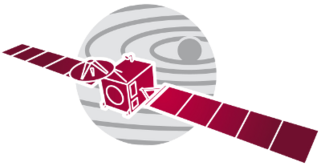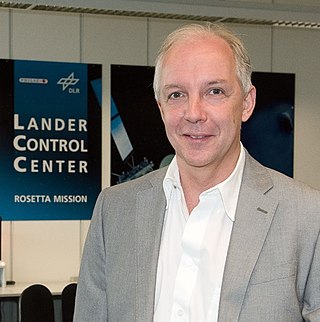Related Research Articles

A comet is an icy, small Solar System body that warms and begins to release gases when passing close to the Sun, a process called outgassing. This produces an extended, gravitationally unbound atmosphere or coma surrounding the nucleus, and sometimes a tail of gas and dust gas blown out from the coma. These phenomena are due to the effects of solar radiation and the outstreaming solar wind plasma acting upon the nucleus of the comet. Comet nuclei range from a few hundred meters to tens of kilometers across and are composed of loose collections of ice, dust, and small rocky particles. The coma may be up to 15 times Earth's diameter, while the tail may stretch beyond one astronomical unit. If sufficiently close and bright, a comet may be seen from Earth without the aid of a telescope and can subtend an arc of up to 30° across the sky. Comets have been observed and recorded since ancient times by many cultures and religions.

Space exploration is the use of astronomy and space technology to explore outer space. While the exploration of space is currently carried out mainly by astronomers with telescopes, its physical exploration is conducted both by uncrewed robotic space probes and human spaceflight. Space exploration, like its classical form astronomy, is one of the main sources for space science.

Rosetta was a space probe built by the European Space Agency launched on 2 March 2004. Along with Philae, its lander module, Rosetta performed a detailed study of comet 67P/Churyumov–Gerasimenko (67P). During its journey to the comet, the spacecraft performed flybys of Earth, Mars, and the asteroids 21 Lutetia and 2867 Šteins. It was launched as the third cornerstone mission of the ESA's Horizon 2000 programme, after SOHO / Cluster and XMM-Newton.

A lander is a spacecraft that descends towards, then comes to rest on the surface of an astronomical body other than Earth. In contrast to an impact probe, which makes a hard landing that damages or destroys the probe upon reaching the surface, a lander makes a soft landing after which the probe remains functional.

67P/Churyumov–Gerasimenko is a Jupiter-family comet. It is originally from the Kuiper belt and has a current orbital period of 6.45 years, a rotation period of approximately 12.4 hours, and a maximum velocity of 135,000 km/h. Churyumov–Gerasimenko is approximately 4.3 by 4.1 km at its longest and widest dimensions. It was first observed on photographic plates in 1969 by Soviet astronomers Klim Ivanovych Churyumov and Svetlana Ivanovna Gerasimenko, after whom it is named. It most recently came to perihelion on 2 November 2021, and will next come to perihelion on 9 April 2028.

Philae was a robotic European Space Agency lander that accompanied the Rosetta spacecraft until it separated to land on comet 67P/Churyumov–Gerasimenko, ten years and eight months after departing Earth. On 12 November 2014, Philae touched down on the comet, but it bounced when its anchoring harpoons failed to deploy and a thruster designed to hold the probe to the surface did not fire. After bouncing off the surface twice, Philae achieved the first-ever "soft" (nondestructive) landing on a comet nucleus, although the lander's final, uncontrolled touchdown left it in a non-optimal location and orientation.

Rosetta is a space probe designed to rendezvous with the comet 67P/Churyumov–Gerasimenko, perform flybys of two asteroids, and carry lander Philae until its landing on 67P. This page records a detailed timeline of this mission.

The Italian Space Agency is a government agency established in 1988 to fund, regulate and coordinate space exploration activities in Italy. The agency cooperates with numerous national and international entities who are active in aerospace research and technology.

The Comet Rendezvous Asteroid Flyby (CRAF) was a cancelled plan for a NASA-led exploratory mission designed by the Jet Propulsion Laboratory during the mid-to-late 1980s and early 1990s, that planned to send a spacecraft to encounter an asteroid, and then to rendezvous with a comet and fly alongside it for nearly three years. The project was eventually canceled when it went over budget; most of the money still left was redirected to its twin spacecraft, Cassini–Huygens, destined for Saturn, so it could survive Congressional budget cutbacks. Most of CRAF's scientific objectives were later accomplished by the smaller NASA spacecraft Stardust and Deep Impact, and by ESA's flagship Rosetta mission.

The nucleus is the solid, central part of a comet, formerly termed a dirty snowball or an icy dirtball. A cometary nucleus is composed of rock, dust, and frozen gases. When heated by the Sun, the gases sublime and produce an atmosphere surrounding the nucleus known as the coma. The force exerted on the coma by the Sun's radiation pressure and solar wind cause an enormous tail to form, which points away from the Sun. A typical comet nucleus has an albedo of 0.04. This is blacker than coal, and may be caused by a covering of dust.
This is a timeline of space exploration which includes notable achievements, first accomplishments and milestones in humanity's exploration of outer space.

Discovery and exploration of the Solar System is observation, visitation, and increase in knowledge and understanding of Earth's "cosmic neighborhood". This includes the Sun, Earth and the Moon, the major planets Mercury, Venus, Mars, Jupiter, Saturn, Uranus, and Neptune, their satellites, as well as smaller bodies including comets, asteroids, and dust.

A Mars flyby is a movement of spacecraft passing in the vicinity of the planet Mars, but not entering orbit or landing on it. Uncrewed space probes have used this method to collect data on Mars, as opposed to orbiting or landing. A spacecraft designed for a flyby is also known as a "flyby bus" or "flyby spacecraft".

CAESAR is a sample-return mission concept to comet 67P/Churyumov–Gerasimenko. The mission was proposed in 2017 to NASA's New Frontiers program mission 4, and on 20 December 2017 it was one of two finalists selected for further concept development. On 27 June 2019, the other finalist, the Dragonfly mission, was chosen instead.

The Planetary Missions Program Office is a division of NASA headquartered at the Marshall Space Flight Center, formed by the agency's Science Mission Directorate (SMD). Succeeding the Discovery and New Frontiers Program Office, it was established in 2014 to manage the Discovery and New Frontiers programs of low and medium-cost missions by third-party institutions, and the Solar System Exploration program of NASA-led missions that focus on prioritized planetary science objectives. The Discovery and New Frontiers programs were established in 1992 and 2001 respectively, and have launched fourteen primary missions together, along with two missions launched under the administration of the Planetary Missions Program Office. The Solar System Exploration Program was established alongside the office, with three missions planned for launch under the new program.

Stephan Ulamec is an Austrian geophysicist, born in Salzburg on January 27, 1966, with more than 100 articles in peer-reviewed journals and several participations in space missions and payloads operated by diverse space agencies. He is working at the German Aerospace Center in Cologne. He is regularly giving lectures about his publications in aerospace engineering at the University of Applied Sciences: Fachhochschule FH-Aachen. Main aspects of his work are related to the exploration of small bodies in the solar system.
References
- ↑ McDowell, Jonathan. "Launch Log". Jonathan's Space Page. Retrieved 21 January 2013.
- ↑ Krebs, Gunter. "Interplanetary Probes". Gunter's Space Page. Retrieved 21 January 2013.
- ↑ "Solar System Exploration - ISEE-3/ICE". NASA. Archived from the original on 4 June 2015. Retrieved 23 April 2013.
- ↑ "Solar System Exploration - Vega 1". NASA. Archived from the original on 3 October 2006. Retrieved 23 April 2013.
- ↑ "Solar System Exploration - Vega 2". NASA. Archived from the original on 3 October 2006. Retrieved 23 April 2013.
- ↑ "Solar System Exploration - Sakigake". NASA. Archived from the original on 18 August 2004. Retrieved 23 April 2013.
- 1 2 "Solar System Exploration - Giotto". NASA. Archived from the original on 20 August 2004. Retrieved 23 April 2013.
- 1 2 "Solar System Exploration - Suisei". NASA. Archived from the original on 20 August 2004. Retrieved 23 April 2013.
- ↑ Wilson-Harrington is catalogued as both a comet and an asteroid
- ↑ "Solar System Exploration - Deep Space 1". NASA. Archived from the original on 20 August 2004. Retrieved 23 April 2013.
- ↑ "Rosetta's lander Philae wakes up from hibernation". European Space Agency, Rosetta Blog. 14 June 2015. Retrieved 14 June 2015.
- ↑ Baldwin, Emily (20 July 2015). "Rosetta and Philae status update". European Space Agency. Retrieved 11 August 2015.






